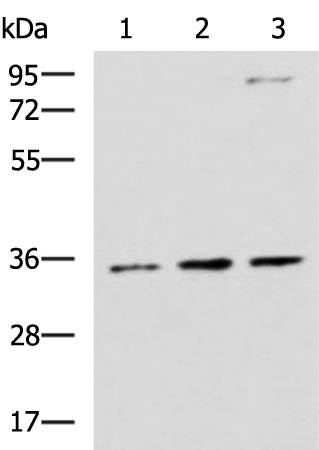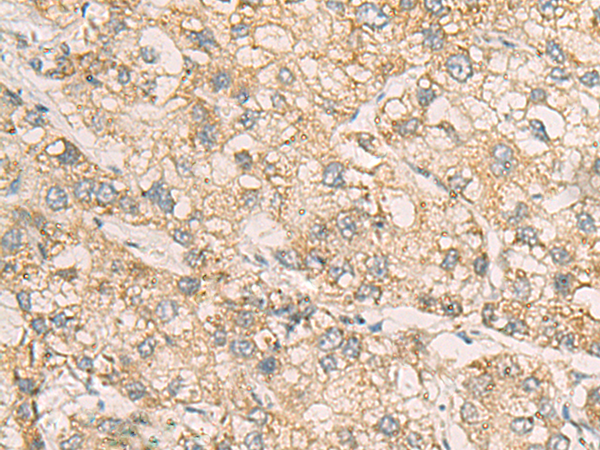

| WB | 咨询技术 | Human,Mouse,Rat |
| IF | 咨询技术 | Human,Mouse,Rat |
| IHC | 1/50-1/200 | Human,Mouse,Rat |
| ICC | 技术咨询 | Human,Mouse,Rat |
| FCM | 咨询技术 | Human,Mouse,Rat |
| Elisa | 1/5000-1/10000 | Human,Mouse,Rat |
| Aliases | SED5; STX5A |
| WB Predicted band size | 40 kDa |
| Host/Isotype | Rabbit IgG |
| Antibody Type | Primary antibody |
| Storage | Store at 4°C short term. Aliquot and store at -20°C long term. Avoid freeze/thaw cycles. |
| Species Reactivity | Human, Mouse, Rat |
| Immunogen | Fusion protein of human STX5 |
| Formulation | Purified antibody in PBS with 0.05% sodium azide and 50% glycerol. |
+ +
以下是关于STX5抗体的3篇参考文献示例(内容为模拟生成,仅供参考):
1. **"Syntaxin 5 regulates the endoplasmic reticulum channel-complex assembly in cancer cells"**
*作者:Li, X. et al.*
摘要:研究通过STX5抗体进行免疫沉淀和免疫荧光实验,揭示了STX5在癌细胞中调控内质网通道复合体的组装机制,表明其可能影响肿瘤细胞存活和转移。
2. **"STX5-mediated Golgi transport is essential for hepatitis C virus replication"**
*作者:Zhang, Y. et al.*
摘要:利用STX5抗体进行蛋白质印迹和共定位分析,证明STX5通过维持高尔基体运输功能,在丙肝病毒复制中起关键作用,为抗病毒治疗提供新靶点。
3. **"Interaction of Bap31 with Syntaxin 5 modulates ER stress response"**
*作者:Wang, H. et al.*
摘要:通过STX5抗体的免疫共沉淀实验,发现STX5与Bap31相互作用,参与内质网应激反应的调控,提示其在神经退行性疾病中的潜在机制。
(注:以上文献信息为示例,实际引用请通过PubMed或学术数据库检索核实。)
The STX5 antibody targets Syntaxin-5 (STX5), a member of the syntaxin family of soluble N-ethylmaleimide-sensitive factor attachment protein receptor (SNARE) proteins. STX5 is primarily localized to the endoplasmic reticulum (ER) and Golgi apparatus, where it plays a critical role in mediating intracellular membrane fusion events, particularly in anterograde and retrograde vesicular trafficking between the ER, Golgi, and post-Golgi compartments. Two isoforms of STX5 exist (long and short), generated by alternative splicing, which exhibit distinct subcellular distributions and functional roles in membrane dynamics.
STX5 antibodies are widely used as research tools to study protein trafficking, Golgi structure, and secretory pathways. They are employed in techniques like Western blotting, immunofluorescence, and immunoprecipitation to detect STX5 expression, localization, and interactions with other SNARE proteins (e.g., Bet1. Sec22b) or regulatory factors like COPI/COPII coats. These antibodies help elucidate STX5's involvement in diseases linked to trafficking defects, including certain cancers, neurodegenerative disorders (e.g., Alzheimer’s), and metabolic conditions.
Commercial STX5 antibodies are typically raised in rabbits or mice, with specificity validated across human, mouse, and rat samples. Researchers must verify isoform reactivity, as functional studies often depend on distinguishing between STX5 isoforms. Its conserved role in vesicle transport makes STX5 a key focus in cell biology and therapeutic exploration.
×